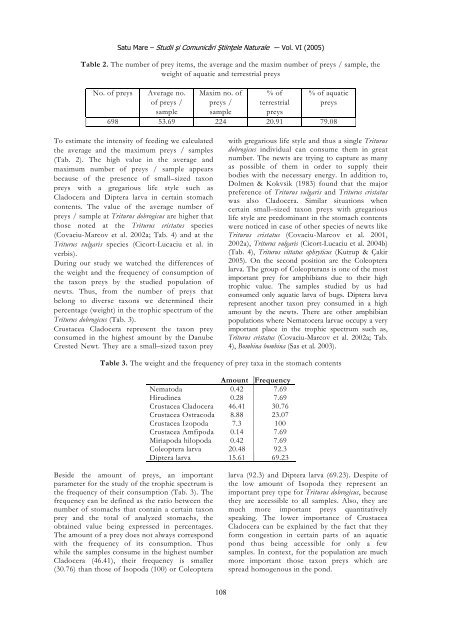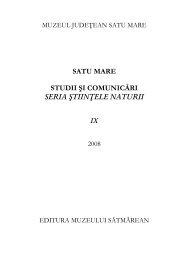Referenţi ştiinţifici - Muzeul Judeţean Satu Mare
Referenţi ştiinţifici - Muzeul Judeţean Satu Mare
Referenţi ştiinţifici - Muzeul Judeţean Satu Mare
Create successful ePaper yourself
Turn your PDF publications into a flip-book with our unique Google optimized e-Paper software.
<strong>Satu</strong> <strong>Mare</strong> – Studii şi Comunicări Ştiinţele Naturale -– Vol. VI (2005)<br />
Table 2. The number of prey items, the average and the maxim number of preys / sample, the<br />
weight of aquatic and terrestrial preys<br />
No. of preys Average no.<br />
of preys /<br />
sample<br />
Maxim no. of<br />
preys /<br />
sample<br />
108<br />
% of<br />
terrestrial<br />
preys<br />
% of aquatic<br />
preys<br />
698 53.69 224 20.91 79.08<br />
To estimate the intensity of feeding we calculated<br />
the average and the maximum preys / samples<br />
(Tab. 2). The high value in the average and<br />
maximum number of preys / sample appears<br />
because of the presence of small–sized taxon<br />
preys with a gregarious life style such as<br />
Cladocera and Diptera larva in certain stomach<br />
contents. The value of the average number of<br />
preys / sample at Triturus dobrogicus are higher that<br />
those noted at the Triturus cristatus species<br />
(Covaciu-Marcov et al. 2002a; Tab. 4) and at the<br />
Triturus vulgaris species (Cicort-Lucaciu et al. in<br />
verbis).<br />
During our study we watched the differences of<br />
the weight and the frequency of consumption of<br />
the taxon preys by the studied population of<br />
newts. Thus, from the number of preys that<br />
belong to diverse taxons we determined their<br />
percentage (weight) in the trophic spectrum of the<br />
Triturus dobrogicus (Tab. 3).<br />
Crustacea Cladocera represent the taxon prey<br />
consumed in the highest amount by the Danube<br />
Crested Newt. They are a small–sized taxon prey<br />
with gregarious life style and thus a single Triturus<br />
dobrogicus individual can consume them in great<br />
number. The newts are trying to capture as many<br />
as possible of them in order to supply their<br />
bodies with the necessary energy. In addition to,<br />
Dolmen & Kokvsik (1983) found that the major<br />
preference of Triturus vulgaris and Triturus cristatus<br />
was also Cladocera. Similar situations when<br />
certain small–sized taxon preys with gregarious<br />
life style are predominant in the stomach contents<br />
were noticed in case of other species of newts like<br />
Triturus cristatus (Covaciu-Marcov et al. 2001,<br />
2002a), Triturus vulgaris (Cicort-Lucaciu et al. 2004b)<br />
(Tab. 4), Triturus vittatus ophryticus (Kutrup & Çakir<br />
2005). On the second position are the Coleoptera<br />
larva. The group of Coleopterans is one of the most<br />
important prey for amphibians due to their high<br />
trophic value. The samples studied by us had<br />
consumed only aquatic larva of bugs. Diptera larva<br />
represent another taxon prey consumed in a high<br />
amount by the newts. There are other amphibian<br />
populations where Nematocera larvae occupy a very<br />
important place in the trophic spectrum such as,<br />
Triturus cristatus (Covaciu-Marcov et al. 2002a; Tab.<br />
4), Bombina bombina (Sas et al. 2003).<br />
Table 3. The weight and the frequency of prey taxa in the stomach contents<br />
Beside the amount of preys, an important<br />
parameter for the study of the trophic spectrum is<br />
the frequency of their consumption (Tab. 3). The<br />
frequency can be defined as the ratio between the<br />
number of stomachs that contain a certain taxon<br />
prey and the total of analyzed stomachs, the<br />
obtained value being expressed in percentages.<br />
The amount of a prey does not always correspond<br />
with the frequency of its consumption. Thus<br />
while the samples consume in the highest number<br />
Cladocera (46.41), their frequency is smaller<br />
(30.76) than those of Isopoda (100) or Coleoptera<br />
Amount Frequency<br />
Nematoda 0.42 7.69<br />
Hirudinea 0.28 7.69<br />
Crustacea Cladocera 46.41 30.76<br />
Crustacea Ostracoda 8.88 23.07<br />
Crustacea Izopoda 7.3 100<br />
Crustacea Amfipoda 0.14 7.69<br />
Miriapoda hilopoda 0.42 7.69<br />
Coleoptera larva 20.48 92.3<br />
Diptera larva 15.61 69.23<br />
larva (92.3) and Diptera larva (69.23). Despite of<br />
the low amount of Isopoda they represent an<br />
important prey type for Triturus dobrogicus, because<br />
they are accessible to all samples. Also, they are<br />
much more important preys quantitatively<br />
speaking. The lower importance of Crustacea<br />
Cladocera can be explained by the fact that they<br />
form congestion in certain parts of an aquatic<br />
pond thus being accessible for only a few<br />
samples. In context, for the population are much<br />
more important those taxon preys which are<br />
spread homogenous in the pond.




